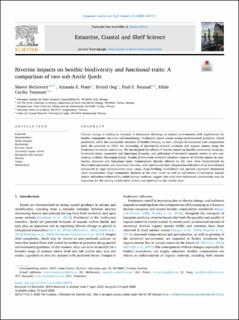Riverine impacts on benthic biodiversity and functional traits: A comparison of two sub-Arctic fjords
Peer reviewed, Journal article
Published version
Permanent lenke
https://hdl.handle.net/11250/2677213Utgivelsesdato
2020Metadata
Vis full innførselSamlinger
Originalversjon
Mcgovern, M., Poste, A., Oug, E., Renaud, P. E. & Trannum, H. C. (2020). Riverine impacts on benthic biodiversity and functional traits: A comparison of two sub-Arctic fjords. Estuarine, Coastal and Shelf Science, 240. doi: 10.1016/j.ecss.2020.106774Sammendrag
Climate change is leading to increases in freshwater discharge to coastal environments with implications for benthic community structure and functioning. Freshwater inputs create strong environmental gradients, which potentially affect the community structure of benthic infauna. In turn, changes in functional trait composition have the potential to affect the processing of terrestrially-derived nutrients and organic matter along the freshwater to marine continuum. We investigated the effects of riverine inputs on benthic community structure, functional traits, taxonomic and functional diversity, and utilization of terrestrial organic matter in two contrasting northern Norwegian fjords. Results of this study revealed extensive impacts of riverine inputs on community structure and functional traits. Communities directly affected by the river were characterized by diminished taxonomic and functional diversity, with species and trait composition indicative of an environment influenced by high sedimentation rates. Large, deep-dwelling, biodiffusors and upward conveyors dominated these communities. High community biomass at the river outlet as well as indications of terrestrial organic matter utilization evidenced by stable isotope analyses, suggest that such river-influenced communities may be important for the cycling of terrestrial carbon and nutrients in the coastal zone.

